|
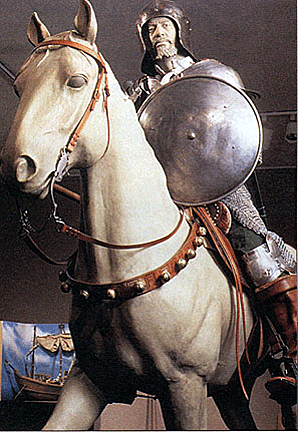 Bearing
a penant of blue and white crowned with a red cross Hernando Cortes, a
34-year-old Spanish soldier, stepped ashore on what is now Mexico on Good
Friday, 1519. Soon he would discover cities larger than any in Spain,
volcanoes reaching into the clouds, armies so vast they seemed to stretch to
infinity, and bloody rituals of human sacrifice. He ended his 83-day,
400-mile journey by conquering one of the greatest civilizations on earth. Bearing
a penant of blue and white crowned with a red cross Hernando Cortes, a
34-year-old Spanish soldier, stepped ashore on what is now Mexico on Good
Friday, 1519. Soon he would discover cities larger than any in Spain,
volcanoes reaching into the clouds, armies so vast they seemed to stretch to
infinity, and bloody rituals of human sacrifice. He ended his 83-day,
400-mile journey by conquering one of the greatest civilizations on earth.
I set out some 480 years later in a bright purple and yellow bus with
Intercontinental Adventures of Mexico City to retrace his route in just 9
days. Of course, I and my fellow tourists fought no battles and stayed in
comfortable, if not luxurious, inns along the way.
We began our trek in Veracruz, Mexico's oldest city. From the Hotel
Imperial, named by Maxmillian, we explored this multi-racial metropolis,
stopping by the new Aquarium, taking in its fascinating architecture, and
later dancing with its people on the zocalo.
Cortes the Diplomat
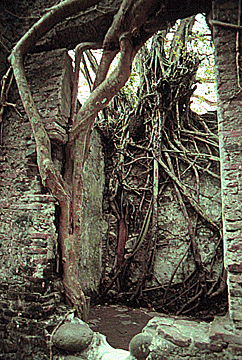 Cortes proved himself a skilled diplomat, winning allies among the Indian
tribes who despised their Aztec overlords. He founded the first European
town in Mexico, Villa Rica de la Vera Cruz, "rich town of the
True Cross," now known as La Antigua, 45 miles north of Veracruz, where
we began to retrace his route. Villa Rica survived for nearly a century
before being supplanted by the present-day port of Veracruz. The most
important buildings today are what remains of Cortes' house, its walls
draped in tree roots and vines, the large ceiba tree to which he
supposedly lashed his ships, and La Hermita del Rosario, the oldest
church in the Americas. Cortes proved himself a skilled diplomat, winning allies among the Indian
tribes who despised their Aztec overlords. He founded the first European
town in Mexico, Villa Rica de la Vera Cruz, "rich town of the
True Cross," now known as La Antigua, 45 miles north of Veracruz, where
we began to retrace his route. Villa Rica survived for nearly a century
before being supplanted by the present-day port of Veracruz. The most
important buildings today are what remains of Cortes' house, its walls
draped in tree roots and vines, the large ceiba tree to which he
supposedly lashed his ships, and La Hermita del Rosario, the oldest
church in the Americas.
The Totonacs, discontented subjects of the Aztecs, invited Cortes to
their capital, Zempoala, "place of 20 waters," our next stop.
Cortes' advance guard came upon the city of 80,000 at night and thought they
had discovered a city of silver. In fact, the walls of the buildings were
covered with white plaster that shown like silver under the full moon. Here
resided the Fat Chief of Zempoala, who told Cortes everything he knew of the
Aztecs, helping him decide to move inland to Tenochtitlan.
Zempoala today is just a large town, its population decimated in the 16th
century by smallpox. Its ruins are impressive. Founded in 1027, it came
under the rule of the Aztecs, who imposed human sacrifice on its people.
Cortes named it New Seville.
His men grew restless. Quelling opposition by hanging two of them,
flogging others, and destroying all but one of his ships, Cortes pressed on
to Xalapa. Now the capital of the State of Veracruz and its chief commercial
center, it features a spectacular archaeological museum, built by the
University of Veracruz, with 3,000 artifacts on display. During the time of
Cortes, Xalapa was a mere village.
Volcanoes and Coffee
Far ahead of us lay snow-capped Pico de Orizaba, at 18,855 feet North
America's third highest peak. Here and there, abandoned sugar cane haciendas
dotted the landscape. We had already climbed 3,000 feet since leaving La
Antigua. With the truncated cones of the old volcanoes Popocatepetl (smoking mountain) and Iztaccihuatl (the white woman) ahead
of us like road markers, we rode on to Coatepec, "heel of the
serpent."
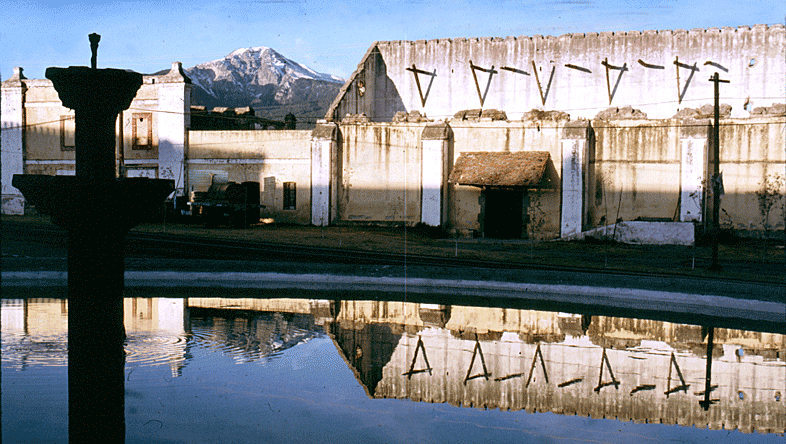
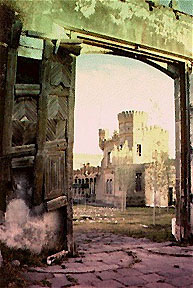 We arrived in early evening, the town veiled in a heavy mist. Its street
lamps, crowned with yellow halos, lit the way to La Parroquia, the parish
church, where a mass was being held. Unlike Cortes' men who camped in the
damp cold, we bedded down for the night at the luxurious Posada Coatepec, a
comfortable inn in the center of town, with rooms named after cities of the
world. The next day, we visited a coffee mill, for Coatepec is today the
center of Mexico's coffee growing region. We arrived in early evening, the town veiled in a heavy mist. Its street
lamps, crowned with yellow halos, lit the way to La Parroquia, the parish
church, where a mass was being held. Unlike Cortes' men who camped in the
damp cold, we bedded down for the night at the luxurious Posada Coatepec, a
comfortable inn in the center of town, with rooms named after cities of the
world. The next day, we visited a coffee mill, for Coatepec is today the
center of Mexico's coffee growing region.
In the hills outside of town, banana plants shade dark green coffee
plants in an atmosphere of a continual soft mist. Local Indians still speak
Nahuatl. Antiquity has an everyday reality here. It was easy to imagine what
this land must have looked like to the conquistadors.
After leaving the Coatepec area, we followed the smooth curving road
toward Cantona and could only imagine what it was like for Cortes to cross
the Name of God Pass, an 11,000-foot saddle in the Sierra Madre. The pass
and the surrounding mountains was the divide between the tropical coast and
the altiplano. Had Cortes chosen to turn back, this would have been the
logical place.
Spread before us was a parched 8,000-foot-high plateau bordered by
Mexico's four highest volcanic peaks. We measured our crossing of this vast
dusty region by the ruins of haciendas. As we crossed the altiplano, maguey
plants, used to make pulque, a pre-Hispanic version of tequilla, ran
in neat rows towards the horizon.
Mysterious Cantona
Cantona, a contemporary civilization to Teotihuacan, looked much as it did
1,000 years ago. This rugged outpost, surrounded by dry, arid land dotted
with old haciendas, was abandoned 300 years before Cortes. Its 500
cobblestone causeways once led to over 3,000 patios on which its 80,000
inhabitants built their houses. The city also had 24 ball courts, more than
any other of its time. The winners of the ball games were treated to three
days of feasting and then were decapitated.
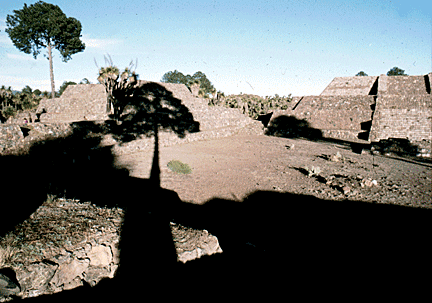 Cortes left the plateau over the Pass of the Firewood, so named by him
because he saw "a thousand cartloads of wood neatly cut." Most
likely it was to be used for firing pottery in nearby towns. Cortes left the plateau over the Pass of the Firewood, so named by him
because he saw "a thousand cartloads of wood neatly cut." Most
likely it was to be used for firing pottery in nearby towns.
We rode on toward Tlaxcala, "place of tortillas," the next
province on Cortes' itinerary, stopping for the night at the Hacienda La
Escondida, a magnificent 19th-century fortress-like structure nestling on
the dry plain in the shadow of La Malinche, the fourth highest of Mexico's
volcanoes. A roaring fire awaited us in the massive dining room. We supped
on chicken enchiladas, drank tequila and told ghost stories.
The Tlaxcalans, the only Indian tribe to have its own republic, attacked
the Spanish soldiers. More than 60 Spaniards were wounded, 45 more died.
Cortes eventually reached a stalemate with the Tlaxcalans. With the help of
his interpreter, Malinche, he formed the alliance that would help him
conquer the Aztecs.
Today, Tlaxcala endures as Mexico's secret treasure and its smallest
state. Known as the largest producer of bulls for the bull ring, it also
boasts the unique archaeological sites of Xochitecatl, with its temples
dedicated to the goddess of fertility, and Cacaxtla, with its delicate
murals painted shortly before 750 AD. The San Francisco Convent, begun in
1524 and the oldest in the Americas, stands out as a highlight. The
Tlaxcalan Indian chiefs were baptized here, with Cortes acting as their
godfather. When they took the faith, Cortes considered them conquered.
The City of Churches
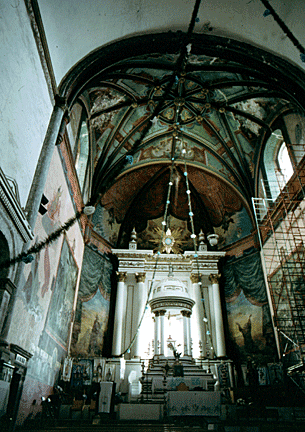 Aztec spies closely watched the events in Tlaxcala. Moctezuma became
increasingly concerned as Cortes set out toward Cholula, the sacred city of
the Aztec god Quetzalcoatl. With 20,000 houses and over 400 temples, it was
the largest city Cortes had encountered. A religious center in Cortes' time,
today, it's a city of churches, with more than any other city in Mexico. Aztec spies closely watched the events in Tlaxcala. Moctezuma became
increasingly concerned as Cortes set out toward Cholula, the sacred city of
the Aztec god Quetzalcoatl. With 20,000 houses and over 400 temples, it was
the largest city Cortes had encountered. A religious center in Cortes' time,
today, it's a city of churches, with more than any other city in Mexico.
On our way to Cholula we stopped in Puebla, the first truly colonial city
in Mexico. Settled in 1539, its streets teem with magnificently restored
colonial mansions, churches and convents. We visited the Palafox Library,
with its 43,000 volumes on ecumenical subjects, and then saw Talavera
pottery being made.
After a brief respite at the Cantina Pasita to sample its famous raisin
liqueur, we walked up Callejon Los Apos (Frog St.), the street of the
antique dealers. Our lodging for the night, the Meson Sacristia de la
Companiea de Jesus (House of the Sacristy of the Company of Jesus),
formerly an antique shop in a private townhouse, is now a hotel with rooms
decorated with antiques--all for sale. All of its nine rooms are named
appropriately after parts of the sacristy in a church.
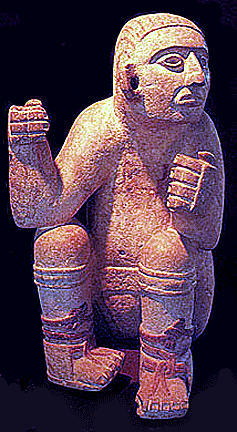 With the great snowcapped volcanoes in front of us, we reached Cholula by
mid-morning on the seventh day. Cholula, "place from which the water
flows," was dominated by the largest pyramid in the world. Today, the
pyramid is crowned by the Church of Nuestra Senora de los Remedios, Our Lady
of the Remedies. With the great snowcapped volcanoes in front of us, we reached Cholula by
mid-morning on the seventh day. Cholula, "place from which the water
flows," was dominated by the largest pyramid in the world. Today, the
pyramid is crowned by the Church of Nuestra Senora de los Remedios, Our Lady
of the Remedies.
Even after the Conquest the Indians remained faithful to the cult of
Quetzalcoatl, so the Spaniards built their churches, at least 365 of them,
on the sites of the former shrines. One of these, the Convent of San
Gabriel, became Cortes' headquarters.
Malinche brought word of a large force of Aztecs preparing for an attack.
At dawn the Spaniards could see from their quarters larger numbers of
Cholulans entering the plaza of the church, supposedly for a religious
service. Without warning, Cortes signaled for his troops to attack the
Indians, and within two hours more than 3,000 lay dead. After this, Cortes
encountered no further resistance as he moved toward Tenochtitlan.
Into the Valley of Mexico
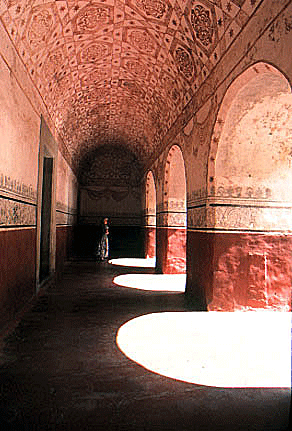 Dusty cornfields gave way to an alpine-like forest as we climbed between the
steep volcanic slopes. From here it was only a short way to the Pass of
Cortes, 12,000 feet above sea level. Once on the other side, Cortes
proceeded to towns in the valley. His and our first stop in the Valley of
Mexico was Amecameca. The Church of Santa Maria de la Ascension on the main
square, offers a secluded Romanesque cloister filled with images of the
Aztec god Chaluc. Dusty cornfields gave way to an alpine-like forest as we climbed between the
steep volcanic slopes. From here it was only a short way to the Pass of
Cortes, 12,000 feet above sea level. Once on the other side, Cortes
proceeded to towns in the valley. His and our first stop in the Valley of
Mexico was Amecameca. The Church of Santa Maria de la Ascension on the main
square, offers a secluded Romanesque cloister filled with images of the
Aztec god Chaluc.
Cortes then trekked over lava flows to Tlalmanalco. We got there by a
roadway overflowing with the fringe traffic of Mexico City. Here we began
our journey through the "Land of the Aztecs." The Spaniards
marched in astonishment across causeways into the populous heart of the
Aztec realm. The causeways are now highways. We encountered dust and
concrete and the refuse of thousands, as modern Mexico City reaches out to
swallow the many towns and lakes of former times.
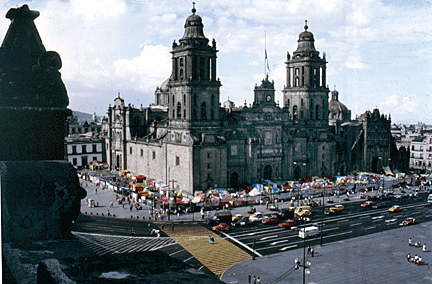 Cortes entered Tenochtitlan on November 8, 1519. It was Friday for us,
the beginning of the weekend. The traffic was formidable. We traveled west
to the broad avenue still called the Tlalpan Causeway. Then wide enough for
eight horsemen to ride abreast, today it has eight lanes, plus a Metro
track. Cortes entered Tenochtitlan on November 8, 1519. It was Friday for us,
the beginning of the weekend. The traffic was formidable. We traveled west
to the broad avenue still called the Tlalpan Causeway. Then wide enough for
eight horsemen to ride abreast, today it has eight lanes, plus a Metro
track.
Within six months of Cortes' arrival, Moctezuma was dead, stoned by his
own people. After terrible riots, Cortes recaptured the city on August 13,
1521.
All this was set in motion in 1519 along the route we had followed. At
times the footprints are faded or covered by the veneer of modern life. But
the path is still there, revealing a Mexico of both past and present. The
Ruta de Cortes connects them both.
<
Back to
history Articles
Go to next History article >
|
